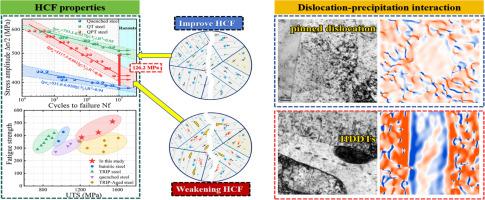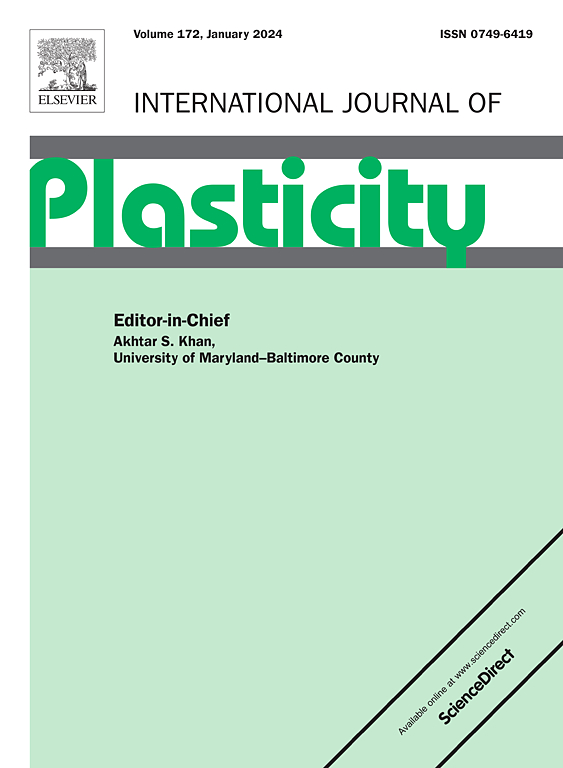Enhancing fatigue life of low-carbon ultra-high strength steel by inducing multi-component precipitates
IF 9.4
1区 材料科学
Q1 ENGINEERING, MECHANICAL
引用次数: 0
Abstract
In this study, the low-carbon ultra-high-strength steels with precipitation-free were prepared using quenching processes, and the co-precipitation strengthening of multi-scale Cu-rich and NiAl were designed to enhance fatigue performance through quenching-tempering (QT) and quenching-partitioning-tempering (QPT) processes respectively. The microstructure of quenched steel shows a typical mixed microstructure of lath martensite (LM) and granular bainite (GB). After aging at 550 °C for 1 h, the high density (1.945 × 1023 m-3) of B2-NiAl and B2 core-9R shell nanoparticles were uniformly co-precipitated and greatly increased the yield strength and high-cycle fatigue strength from 965 MPa and 384.6 MPa to 1548 MPa and 510.7 MPa, respectively. The substantial improvement in fatigue performance is attributed to the large number of small-sized nanoparticles that hinder the movement of dislocations to form high-density dislocation tangles (HDDTs) and cell structures, reducing the stress concentration at grain boundaries. Furthermore, geometric phase analysis (GPA) revealed the existence of micro-strain around small-sized multi-component precipitates, which is less likely to cause micro-crack initiation, thereby enhancing the fatigue performance. After QPT treatment, the co-precipitated nanoparticles exhibited multi-scale distribution with a significantly reduced number density of 1.005 × 1023 m-3, and the typical large-sized FCC-Cu particles are identified, which weakens the precipitation strengthening and leads to the yield strength and fatigue strength reached 1396 MPa and 424.5 MPa respectively. Furthermore, the GNDs obviously accumulate at the interface between reversed austenite (RA) and matrix by the movement of dislocations and bypassed nanoparticles, which increases the tendency of microcrack initiation at the interface. In addition, the high strain accumulated at the interface of FCC-Cu particles increases the risk of fatigue damage and limits the improvement of fatigue performance.


通过诱导多组分析出提高低碳超高强度钢的疲劳寿命
本研究采用淬火工艺制备了无析出的低碳超高强度钢,设计了多尺度富cu和NiAl共析出强化,分别通过调质(QT)和淬火-配分-回火(QPT)工艺提高疲劳性能。淬火钢的组织为典型的条状马氏体(LM)和粒状贝氏体(GB)混合组织。550℃时效1 h后,高密度(1.945 × 1023 m-3)的B2- nial纳米粒子和B2核- 9r壳纳米粒子均匀共析出,屈服强度和高周疲劳强度分别从965 MPa和384.6 MPa大幅提高到1548 MPa和510.7 MPa。大量的小尺寸纳米颗粒阻碍了位错的移动,形成高密度位错缠结(HDDTs)和细胞结构,减少了晶界处的应力集中,从而显著改善了疲劳性能。此外,几何相分析(GPA)表明,小尺寸多组分析出物周围存在微应变,不易引发微裂纹,从而提高了疲劳性能。经QPT处理后,共析出的纳米颗粒呈多尺度分布,数量密度显著降低,为1.005 × 1023 m-3,具有典型的大尺寸FCC-Cu颗粒,其析出强化减弱,屈服强度和疲劳强度分别达到1396 MPa和424.5 MPa。此外,由于位错和旁路纳米颗粒的运动,gds在逆奥氏体与基体的界面处明显富集,增加了界面处微裂纹萌生的倾向。此外,FCC-Cu颗粒界面处积累的高应变增加了疲劳损伤的风险,限制了疲劳性能的提高。
本文章由计算机程序翻译,如有差异,请以英文原文为准。
求助全文
约1分钟内获得全文
求助全文
来源期刊

International Journal of Plasticity
工程技术-材料科学:综合
CiteScore
15.30
自引率
26.50%
发文量
256
审稿时长
46 days
期刊介绍:
International Journal of Plasticity aims to present original research encompassing all facets of plastic deformation, damage, and fracture behavior in both isotropic and anisotropic solids. This includes exploring the thermodynamics of plasticity and fracture, continuum theory, and macroscopic as well as microscopic phenomena.
Topics of interest span the plastic behavior of single crystals and polycrystalline metals, ceramics, rocks, soils, composites, nanocrystalline and microelectronics materials, shape memory alloys, ferroelectric ceramics, thin films, and polymers. Additionally, the journal covers plasticity aspects of failure and fracture mechanics. Contributions involving significant experimental, numerical, or theoretical advancements that enhance the understanding of the plastic behavior of solids are particularly valued. Papers addressing the modeling of finite nonlinear elastic deformation, bearing similarities to the modeling of plastic deformation, are also welcomed.
 求助内容:
求助内容: 应助结果提醒方式:
应助结果提醒方式:


